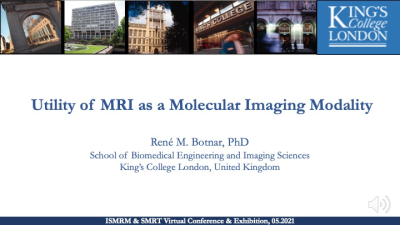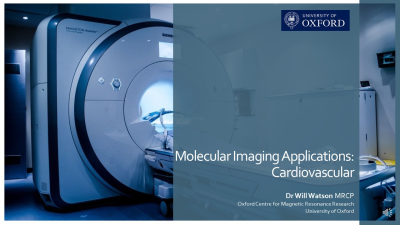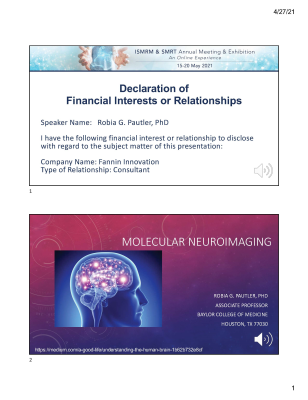Weekend Course
Molecular Imaging
ISMRM & SMRT Annual Meeting • 15-20 May 2021

| Concurrent 2 | 13:45 - 14:30 | Moderators: Michael McMahon |
 |
Utility of MRI as a Molecular Imaging Modality
René Botnar
Molecular imaging promises to provide information on molecular and cellular alterations that precede anatomical or functional disease manifestation. Molecular imaging thus may help to detect pre-symptomatic sub-clinical disease, provide information on molecular markers for targeted drug treatment and improve monitoring of treatment response by visualising the effect of drugs or interventions both at the molecular and anatomical level. In this presentation I will discuss the potential of MR molecular and non-molecular imaging for the non-invasive detection of early and advanced atherosclerosis, and I will discuss the potential of non-molecular MRI and other imaging modalities for cardiovascular risk assessment and prediction.
|
|
| Molecular Imaging Basics: Relaxation-Based Contrast Agents
Thomas Meade
|
||
| Molecular Imaging Basics: CEST Contrast Agents
Kannie WY Chan
Chemical exchange saturation transfer (CEST) MRI has shown many promising biomedical applications. Many natural compounds and clinical agents have inherent CEST contrast. This course will cover the basic principles of CEST and CEST contrast agents, focusing on non-metallic exogenous contrast agents. Target audience: Students, researchers and physicians who are interested in using CEST contrast agents in their applications.
|
||
| Molecular Imaging Applications: Cancer
Michal Rivlin
Molecular Imaging is a growing biomedical research discipline that enables understanding complex pathological processes much earlier than they would be detected using conventional imaging techniques. Recent advances in molecular imaging technologies may assist in providing useful information regarding tumor metabolism and its microstructural changes. This presentation will discuss recent applications in molecular imaging of cancer, such as hyperpolarization, the use of nanoparticles, and CEST agents. The last is emerging as an attractive approach with the capability of generating quantitate contrast of tumors. Hence, useful CEST MRI applications such as APT, glucose and its analogs, pH imaging, etc., will be presented.
|
||
 |
Molecular Imaging Applications: Cardiovascular
William Watson
There are many molecular applications emerging in cardiac MR which give us useful research and clinical insights. 31-phosphorus magnetic resonance spectroscopy demonstrates relative amounts of ATP and Phosphocreatine, showing energy metabolism. Proton spectra can demonstrate cardiac lipid build up or total creatine levels. 31-carbon spectroscopy can be used with dynamic nuclear polarisation to demonstrate metabolism of carbon containing compounds, typically pyruvate in showing up glucose metabolism. 31P MRS has demonstrated to us PCr depletion in heart failure and on exercise in states where energy supply is limiting. 13C shows reduced glycolysis and may be useful in ischaemia imaging.
|
|
 |
Molecular Imaging Applications: Neurological
Robia Pautler
In this presentation, some important aspects to consider when performing Molecular Neuroimaging Studies will be presented. The topics covered in this presentation range from anesthesia choices, awake mouse imaging, contrast agents, cell labeling, 19F studies, contrast agent delivery methods and also validation studies. Clinical as well as preclinical aspects are covered for each topic. The intended audience includes clinicians and basic researchers with a basic or intermediate level of understanding of molecular neuroimaging.
|
|
| Imaging Immune Cells
Paula Foster
|
||
| Perspective on Clinical Translation
Uwe Himmelreich
|
The International Society for Magnetic Resonance in Medicine is accredited by the Accreditation Council for Continuing Medical Education to provide continuing medical education for physicians.